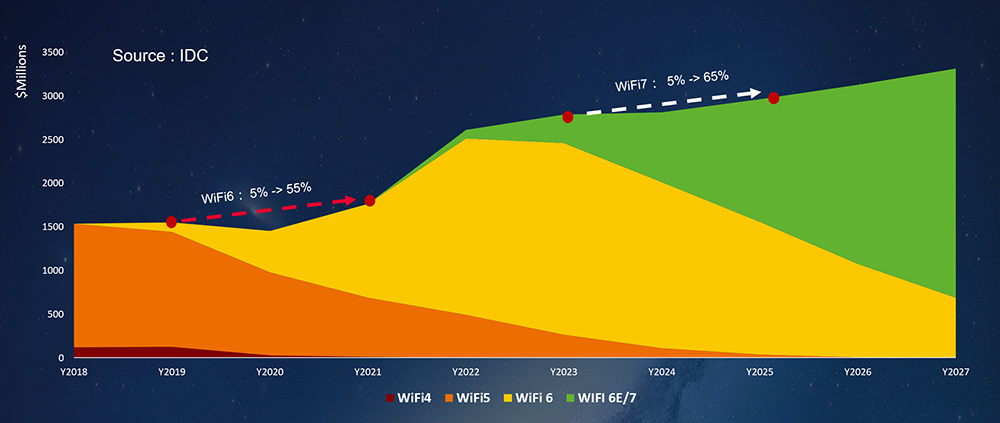Produits, solutions et services pour les entreprises
Fifty years later, Ethernet has become a bridge, connecting almost every computer and mobile phone to the Internet.
This set the scene for Robert Metcalfe, the father of Ethernet, to be named the winner of the ACM A.M. Turing Award, often referred to as the "Nobel Prize of Computing", in March 2023. Indeed, Ethernet has become the lifeblood of today's IT industry, rapidly taking the quality of production and life to new levels.
From email to messaging, from voice to video, we're constantly pursuing higher Ethernet rates. By 2010, the Institute of Electrical and Electronics Engineers (IEEE) was quick to promote the establishment of 100 Mbps, 1000 Mbps, 10 Gbps, and 100 Gbps Ethernet standards to keep up with the ever-changing market demands.
Generally, a new generation of Ethernet delivers 10 times the rate of the previous generation, but this cannot satisfy the growing hunger for bandwidth in today's world. With the rapid rise of Wi-Fi 6, the backhaul bandwidth of an access point has now surpassed 1 Gbps, while the advent of Wi-Fi 7 increases the minimum wireless backhaul rate to 2.5 Gbps.
In just five years, Wi-Fi 6 has replaced more than 50% of Wi-Fi 5 deployments at enterprises, and we can expect Wi-Fi 7 to become the new preferred access choice in the next three years. By that time, as enterprises implement digital upgrades, they will require Wi-Fi 7 devices to meet new terminals and service requirements.


Although it is possible to jump straight to the 10GE standard, the bandwidth for access devices would be underutilized (bandwidth currently required at the access layer: about 2000 Mbps). And to fully enjoy 10GE bandwidth, enterprises would need to upgrade their cables to higher than Cat 6. Furthermore, engineering standards for buildings, such as shopping malls, stadiums, and enterprise office buildings, require switches to be PoE capable, so that cameras and ceiling-mounted APs can be flexibly deployed. The trouble is, the 10GE standard uses optical signals and cannot provide flexible PoE power supply.
This is where the 2.5GE standard (also called NBASE-T) comes in. Born in 2016, 2.5GE provides a new option between the rates 1 Gbps and 10 Gbps.
A 2.5 Gbps rate makes it possible to download a movie of about 1 GB in roughly 4 seconds, faster than most of today's enterprise-class mechanical hard disk drives. Plus, APs capable of 2.5GE backhaul and other devices with 2.5GE network ports work in concert to offer faster transmission on enterprises' internal networks. A typical example for this is 4K video editing, where we can use materials in the cloud and NAS for a superior experience similar to that with local disks on computers.
Another highlight of 2.5GE is flexibility. To elaborate, 2.5GE can make use of existing Cat 5e and Cat 6 cables and automatically adjust network speeds based on cable capabilities without the need to replace legacy cables or terminals. Huawei's 2.5GE technology is uniquely backward compatible with 10 Mbps and 100 Mbps terminals. Thanks to such compatibility, customers in scenarios such as education and healthcare do not need to replace legacy devices when upgrading to 2.5GE. 2.5GE is also PoE capable. As such, there is no need for users to re-plan power supply lines or high-voltage devices when upgrading the network, providing great convenience.
2.5GE shows much promise in a range of use cases. 4K live streaming on today's streaming platforms, for example, usually requires 25 Mbps bandwidth. In other words, a 2.5GE network can theoretically support 100 online users at the same time. This significantly improves the efficiency of organizations looking for large file transfer, multimedia streaming, and real-time communication. 2.5GE technology is also a great fit for environments with high-density connections and diverse terminals of multiple rates. For example, IoT devices proliferate in office buildings, hospitals, and education institutions, while the network is simultaneously accessed by terminals with different rates, such as cameras, printers, APs, and servers. 2.5GE is a good choice for this case, as it offers bandwidth required for the ever-changing network requirements.
To sum up, 2.5GE is the next generation of gigabit networks. It provides strong support for high-density and high-speed scenarios, and is also a key enabler for upgrading gigabit campus networks to high-quality 10 Gbps campus networks.
The question facing today's enterprises is whether, when, and how to upgrade to 2.5GE. To help find the answer, don't miss our next article about the market trend and network value of 2.5GE switches. Until next time!
Disclaimer: The views and opinions expressed in this article are those of the author and do not necessarily reflect the official policy, position, products, and technologies of Huawei Technologies Co., Ltd. If you need to learn more about the products and technologies of Huawei Technologies Co., Ltd., please visit our website at e.huawei.com or contact us.